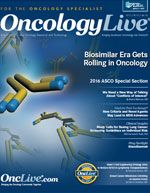Exon 14 Skipping Mutation Could Provide Key to MET Inhibitor Success in Lung Cancer
MET exon 14 skipping mutations are emerging as a particularly promising biomarker, at least in the context of lung cancer.
Ravi Salgia, MD, PhD
Despite a strong rationale for targeting the tyrosine kinase receptor MET, drug development has proved fraught with challenges. Finding biomarkers that allow optimal patient selection is likely to be the key to success.
MET exon 14 skipping mutations are emerging as a particularly promising biomarker, at least in the context of lung cancer. First discovered over a decade ago, more than 100 different mutations resulting in exon 14 skipping have been described.
These mutations occur in the sites at which splicing takes place during the processing of precursor messenger RNA (mRNA) into mature mRNA and, in the MET gene, they result in exon 14 being spliced out—hence, “skipping” the protein region encoded by this exon.
Activation of the MET receptor is tightly controlled, in part by negative regulation through degradation of the protein. Exon 14 encodes the juxtamembrane region of the MET protein, which contains a tyrosine residue that recruits the ubiquitin ligase Cbl. Cbl tags the MET receptor for degradation in the lysosome, the digestive organelle; therefore, exon 14 skipping means the activated MET receptor fails to be properly degraded.
These types of mutations occur predominantly in tumors with adenocarcinoma histology, in an estimated 3%-4% of patients.1 They are found in both the presence and absence of MET gene amplification, another promising biomarker. Unlike EGFR, ROS, and ALK alterations, which tend to occur in light- or never-smokers, MET exon 14 deletions are found in both never-smokers and ever-smokers. They also uniquely tend to occur in older patients. Importantly, several recent studies have demonstrated that these are actionable events in lung cancer and that patients harboring these mutations can experience clinical benefit when treated with MET inhibitors.
Three different MET inhibitors have shown single-agent activity against MET exon 14 deletions, displaying durable partial responses, leading some researchers to suggest that it may provide a new route to MET inhibitor approval in lung cancer. These agents include crizotinib (Xalkori), cabozantinib (Cabometyx; Cometriq), and the novel small molecule capmatinib (INC280).
OncologyLive: How has our understanding of the role of the MET pathway in cancer evolved?
What have we learned from phase III failures of MET-targeting drugs?
In an interview with OncologyLive, Ravi Salgia, MD, PhD, emphasized the importance of biomarker identification in meeting the potential of MET-targeting therapy. Salgia is the Arthur & Rosalie Kaplan Chair in Medical Oncology and associate director for clinical sciences at City of Hope’s Comprehensive Cancer Center in California. He was part of the original team that discovered MET exon 14 deletion mutations.Salgia: MET’s come a long way. Obviously, since its discovery in 1984, a lot of basic science has gone on. Then, with the discovery of small-molecule inhibitors in 2002-2003 and ultimately clinical trials around 2005, we’ve learned a lot. It has become an important issue to say are we going to inhibit c-MET through tyrosine kinase inhibition like a small-molecule inhibitor or antibody inhibition, and those are all coming to fruition and have come to fruition. We have learned from what has worked, but we have also learned from what has not worked.What we’ve learned is that not the right biomarkers were potentially chosen. The anti-MET or the anti-HGF trials and selection criteria were based on immunohistochemistry, but it depended on one antibody versus another antibody, so it really depended on the epitope. But the activated form of MET was not looked at, nor was the amplification of MET, nor mutations of MET.
So we’ve learned from, for example, in the EGFR world or the ALK translocation world for non—small cell lung cancer, that we really need to be able to drill down to the molecular genetics and then come back and ask whether the therapy will work or not.
What progress has been made in identifying biomarkers for patient stratification?
N-of-1 case studies, where they showed MET amplification or exon 14 skipping, which we discovered in lung cancer, responds to certain inhibitors. So I think initially we were very concerned that the phase III studies were negative but then, looking at it retrospectively, we had this guide that we need better biomarkers.I certainly think there’s exon 14 skipping that’s in the juxtamembrane domain and our first paper that described it initially for lung cancer actually was in 2003. It turns out that this exon 14 skipping, the juxtamembrane domain deletion, is an important biomarker to select out the patients for certain drugs that they respond to.
What is the future of MET as a drug target?
At the same time, MET amplification seems to be also pretty good. Initially, there had been studies that showed that you could have MET amplification with certain tyrosine kinase inhibitor resistance, but actually MET amplification we know also can appear de novo. So those are important biomarkers that are coming to fruition now.I believe strongly that it’s going to be like EML4-ALK, ROS1, or EGFR mutations that occur in non—small cell lung cancer in that, if you identify the right biomarker with the right patient, [the drug] will be effective.
We’re excited that indeed it occurs in enough of a subset of a lung cancer population, as an example, that it will make a huge breakthrough, and I also believe it’s already making that breakthrough. But it might be very relevant for other diseases, too, be it head and neck cancers, glioblastoma multiforme, or gastric cancers, and we just have to be able to select the right patient for the right drug. For me, MET [targeting] is absolutely real and it’s coming to fruition now.
Reference
- Lovly C, Paik P. MET exon 14 skipping mutations in lung cancer. My Cancer Genome website. www.mycancergenome.org/content/disease/ lung-cancer/met/343/. Updated February 5, 2016. Accessed June 2, 2016.




